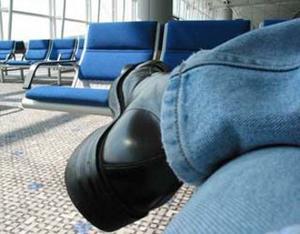Aviation securityTSA looking for shoe scanning devices
DHS is seeking companies to which it will award a contract for shoe scanners; according to the Office of Federal Business Opportunities, the Shoe Scanning Device (SSD) system currently sought by the TSA and DHS “will be capable of detecting threat objects concealed in footwear without requiring passengers to remove their footwear as they pass through a security checkpoint. These threat objects include a wide variety of military, commercial, and homemade explosives or explosives devices”

The goal is a walk-through shoe scanner // Source: airport-int.com
TSA announced this week that it will be accepting proposals for a “shoe scanner” device. The agency is seeking companies to which they will award the contract for the shoe scanners, and according to the Office of Federal Business Opportunities, the Shoe Scanning Device (SSD) system currently sought by the TSA and DHS “will be capable of detecting threat objects concealed in footwear without requiring passengers to remove their footwear as they pass through a security checkpoint. These threat objects include a wide variety of military, commercial, and homemade explosives or explosives devices.”
A dozen companies have designed shoe scanning machines, and the TSA says it plans to buy 100 of the devices by next year. According toUSA Today, machines, which find metal weapons and explosives in shoes, did not pass muster in tests three years ago. The developers of the latest generation of the machines promise better results, and the TSA says the technology will improve security.
Letting travelers keep shoes on “would help checkpoints run more smoothly and allow our officers to focus on other aspects of security,” TSA spokeswoman Sterling Payne said. The agency is now reviewing information from the inventors.
One company, IDO Security, has shoe scanners in more than 15 overseas locations, company President Michael Goldberg said. IDO’s “MagShoe,” which costs $4,400 to $7,000, also is used at a cruise-ship terminal in Florida to screen passengers, crew, and vendors, Goldberg said.
The TSA began forcing some passengers to remove shoes in late 2001 after “shoe-bomber” Richard Reid tried to ignite explosives in his boots on a U.S.-bound flight. Shoe removal became mandatory in 2006 after a foiled plot to blow up U.S.-bound planes with liquid explosives.
The TSA tested a scanner in 2007 at Orlando International Airport but pulled it after seven months because the machine missed too many weapons and bomb parts during tests. The scanner also troubled some passengers because it sounded alarms on shoes containing harmless metal. The TSA says travelers often rate shoe-removal as the biggest hassle of checkpoint screening.
The scanners tested in 2007 were produced through a partnership between the TSA and General Electric. The TSA says they rejected the earlier GE contract because the shoe scanning feature on the machine presented for testing does not meet minimum detection standards. While significant improvements were made, the shoe scanner still does not meet standards to ensure detection of explosives.
The
